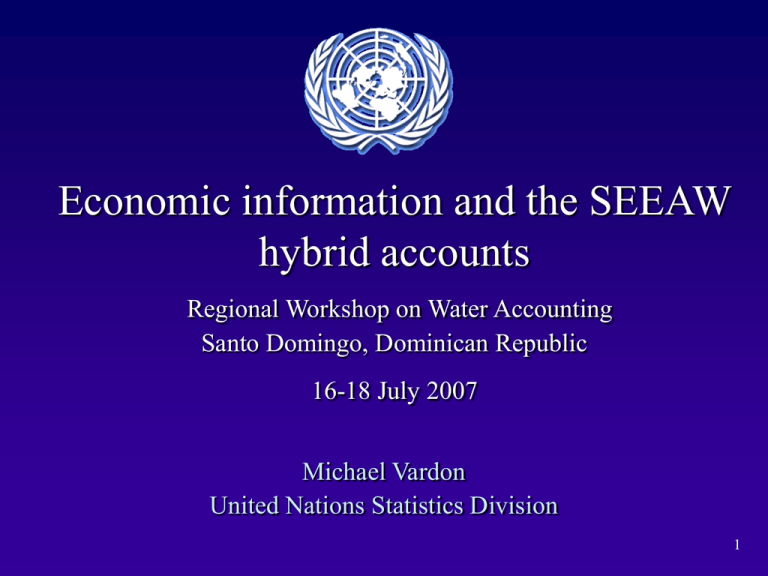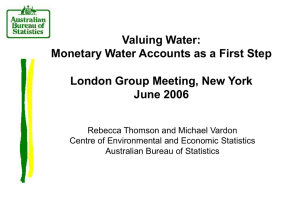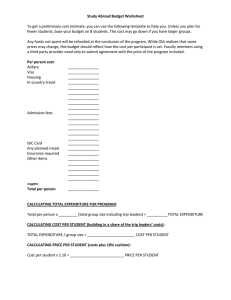Economic information and the SEEAW hybrid accounts Regional Workshop on Water Accounting
advertisement

Economic information and the SEEAW hybrid accounts Regional Workshop on Water Accounting Santo Domingo, Dominican Republic 16-18 July 2007 Michael Vardon United Nations Statistics Division 1 Outline • • • • • What do hybrid accounts measure? Concepts The standard tables of SEEAW Supplementary tables/information Examples from Australia and the Netherlands The hybrid tables • Hybrid supply and use tables • Hybrid accounts • Hybrid accounts for water-related activities for own use • Government accounts for water-related services • National expenditure and financing Why compiling economic accounts for water? To identify • The costs associated with production of waterrelated products and income generated by the production • The investment in water-related infrastructure • Costs of maintaining the infrastructure • Fees paid by users for water-related services and subsidies received • Other economic instruments used for the management of the resources => Help to design policies of cost-recovery and efficient water allocation Hybrid supply Hybrid Supply table (Table 5.1, page 66 of SEEAW) consist of 3 parts: 1) Monetary supply (in monetary units) (Output + imports); 2) Physical supply: water supplied to other units and discharged to the environment (in physical units); 3) Emission of pollutants (gross): pollutants added to water as a result of production and consumption. Columns: Industries classified by ISIC ISIC 36 main supplier of water, other industries also may supply water as secondary activity Rows: Products classified by CPC ver. 2 Natural water + distribution services Sewerage Hybrid Supply Table Billions currency units, Millions cubic metres Output of industries (by ISIC categories) 35 1. Total output and supply (Billions currency units) of which: 1.a Natural water (CPC 1800) 1.b Sewerage services (CPC 941) of 5-33, which: 1-3 41-43 Total Hydro 137.6 749.0 22.1 3.3 0.0 0.040 0.0 0.0 2. Total supply of water (Millions cubic metres) 82.9 2.a Supply of water to other economic units 17.9 of which: 2.a.1- Wastewater to Sewerage 17.9 2.b Total returns 65.0 3. Total (gross) emissions of COD (Thousand of tonnes) 3150.2 0.0 0.0 157.0 405.6 127.6 5.6 117.6 5.6 29.4 400.0 5047.4 7405.1 0.0 0.0 36 1.7 Total Total Taxes less Trade and supply at output, 38,39, at basic Subsidies transport purchaser’s 37 45-99 prices Imports on products margins price 9.0 367.0 1286.4 363.0 70.0 0.0 1719.4 1.7 0.0 0.2 8.8 300.0 426.9 0.0 379.6 0.0 1.4 300.0 47.3 0.0 1851.0 0.0 0 1.9 8.8 0.0 0.0 526.5 49.8 1648.7 42.7 49.1 622.5 0.0 49.1 191.6 483.8 0.7 1026.2 498.5 1973.8 19925.9 0.0 0.0 0.0 -0.1 0.0 0 1.9 8.8 1648.7 622.5 191.6 1026.2 19925.9 Hybrid use table Table 5.2 (page 70 of SEEAW) consists of two parts: • Monetary use table Shows the destination of produce in terms of: • Intermediate consumption • Actual final consumption of households and government • Gross capital formation • Exports Final consumption expenditure and actual final consumption • Total final consumption may be calculated as: • Final consumption expenditure = Total value of expenditures on individual and collective goods and services of households, NPISHs and government • Actual consumption expenditure = Value of individual goods and services acquired by households plus the value of collective services provided by the government (See box on page 68 of SEEAW) Final consumption expenditure and actual final consumption Final consumption expenditure Households (a) NPSHIs individua l (b) Government Collective (c) Individual (d) Total use of products Actual Consumption Households Final consumption expenditures (a) Social transfers in kind from Government and NPISHs (b)+(d) Government ( c) Total (a)+(b)+ (c)+(d) Total (a)+(b)+ (c)+(d) Individual and collective goods and services • Individual goods and services of government and NPISHs are those incurred for the benefit of individual households (e.g. supply of water to households by government, etc.) • Collective goods and services of government are those incurred for the benefit of the community (e.g. water management, legislation and regulation) Hybrid accounts for SUT • Combine supply and use of water in a single table for deriving hydrologic-economic indicators • Table 5.3 (page 71) consists of 2 parts: • Monetary SUT [items 1-6] • Supply, use, value added and gross capital formation –total and water-related [1-4] • Stocks of water-related fixed assets [5, 6] • Physical SUT [items 7-9] • Use of water [7] • Supply of water [8] • Gross emissions [9] Hybrid accounts for waterrelated activities for own use • Objective is to separately identify the cost and output of water-related activities for own use because costs of activities for own use are incorporated in those of the principal activity • Hybrid accounts for own use are carried out for: • Water collection treatment and supply • Sewerage • Remediation activities related to water Government accounts for water-related activities • Government expenditure (collective) on water related activities are classified by Classifications of Functions of Government – COFOG • It includes the following categories: • Wastewater management • Soil and groundwater protection • Environmental protection n.e. c. • Water supply National expenditure accounts • Aim at recording the expenditure of resident units and financed by resident units for environmental protection • CEPA-2000 (Classification of Environmental Protection Activities) is the classification for EP It classifies: • EP activities (Activities whose primary purpose is the protection of the environment) • EP products (e.g. septic tanks) • Expenditures for EP (investment grants, taxes, subsidies, acquisition of land for EP, etc.) Environmental Protection related to water • CEPA-2000 related to water include: • Wastewater management • Activities of sewerage, administration, use of specific products (e.g septic tanks) and specific transfers • Water management and exploitation • Activities for the collection, treatment and supply of water, legislation, administration and specific transfers National expenditure accounts for wastewater management • Table 5.6 (page 82 of SEEAW) includes, by row: • Use of wastewater services [Item 1] • Gross capital formation for producing EP services including acquisition of land [2] • Use of connected and adapted products (septic tanks and collecting sludge) [3] • Specific transfers (current and capital transfers, earmarked taxes, subsidies, etc.) [4] • National expenditure = Total domestic uses [5= 1+2+3+4] – the part financed by the ROW [6] National expenditure for wastewater management • Table 5.6 by column: • Specialized producers (ISIC 37 is the principal activity) • Other producers • Final consumers • ROW Financing accounts Purpose: • To identify the financing sector of water related products and the beneficiaries • It analyzes transfers (e.g. subsidies, investment grants, taxes) from whom to whom Financing accounts • Table 5.7 (page 83 of SEEAW) shows how wastewater is financed: • By row: Financing sectors – institutional sectors in the SNA • By column the Beneficiaries (same as table 5.6) Country experiences • The Netherlands – linking economic data to river basins • Australia – experimental monetary accounts Linking Economic Accounts to the River Basin The Netherlands based on: “Integrated river basin accounting in the Netherlands and the European Water Framework Directive” (Brouwer et al, Statistical J. of the UNECE 22 2005) Water Framework Directive (FWD) and Hybrid Accounts • WFD: increase in demand for water-related data • Use Hybrid Accounts which provide information on - Intensity of water use by branches of industry - The physical flows of supply of water services - Production costs of water services - Environmental taxes related to water - at National and River Basin level Dutch River Basins • As Rhine covers 70% of Dutch territory is split-up 4 sub-regions: North, East, West and Centre River Basins vs Regional Economic Accounts Regional Economic Accounts • 12 Provinces • 40 Administrative Regions • Each COROP region consists of several municipalities • 512 Municipalities • Regional accounts are for the 40 Administrative Regions • Focus on the production process in each unit, in the various regions Assigning Regional Accounts to River Basins (1) ECONOMIC DATA • 23 Regional Accounts fall directly within a specific River Basin • Other 17 overlap: economic data allocated based on estimated percentage of employees working in a specific River Basin • Reason: no economic data available at individual company level Method: • Identify specific branches of industry in these COROPs • Identify number of employees in these branches • Identify municipalities where these business units are located • If municipalities fall into 2 River Basins: Postal codes • If single postal code falls into 2 River Basins: business units and employees are allocated based on area of the postal code falling in that River Basin Value added by River Baisn – Netherlands Rhine west Rhine mid Rhine east Rhine north Meuse Scheldt Ems 3% 3% 21% 50% 5% 10% 8% • Distribution of economic value added generated in the various river basins in the Netherlands GDP and environmental indicators: Netherlands 130 125 120 115 wastewater nutrients heavy metals GDP 110 105 100 95 90 85 80 1996 1997 1998 1999 2000 2001 • Suggests that water is used in a more efficient way GDP and environmental indicators: SCHELD River Basin – Netherlands 140 130 120 110 wastewater nutrients heavy metals GDP 100 90 80 70 60 1996 1997 1998 1999 2000 2001 Confidentiality – a Netherlands • It concerns economic data and water flow data • Rules: • Sector should consist of at least 3 or more companies • The largest company cannot employ more than 75% of employees in a specific region • Largest company in a specific branch of industry cannot employ more than 70% of total freshwater in that region • In terms of representation: confidentiality problems are solved by presenting two sectors together Example: Water use per River Basin per sector only compiled for 2 largest River Basins due to confidentiality reasons Australian experimental monetary water accounts • Enable the economic costs and benefits of water supply to matched with physical data on water stocks and flows. • Informs more efficient water allocations: • ideally, require information on: physical water flows; prices paid for water used; value added of water users • Costs and benefits can occur: • Now/later (temporal) • Here/there (spatial) • Public/private (and between industries), especially public water supply and private agricultural water use Water use in Australia and scope of the monetary account Selfextracted (GL) Agriculture Distributed Water (GL) Reuse Water (GL) InStream (GL) Water Consumption (GL) 6,582 5,329 280 Mining 529 72 7 Manufacturing 246 341 13 589 Water Supply 11,160 2,045 39 2,083 Electricity and Gas 60,172 115 6 59,867 271 All other industries 862 1,561 78 386 1,021 Households 232 1,874 2 79,783 11,337 425 Total 12,191 183 413 2,108 60,436 18,676 Classification of products and assets Four products were selected for revenue/expenditure data: 1. Urban distributed water 2. Rural distributed water 3. Bulk water 4. Wastewater/sewerage services Three assets selected for asset values: 1. Urban water supply infrastructure assets; 2. Urban sewerage infrastructure assets; and 3. Irrigation and drainage infrastructure assets Primary data sources and reference year Supply side: • ABS Economic Activity Survey • State government, industry association and company annual reports Use Side: • Households: State government reports, WSAA facts • Agriculture: Water Use on Australian Farms • Other industries: Economic Activity Survey • Sewerage services: Environmental Protection Expenditure Account 1996-97 Reference year: 2003-04 Results – economic output • Total output of water & sewerage services in was AUD$7.3 billion, of which; - sewerage services generated AUD$3.4 billion; - urban water sales generated AUD$3.3 billion; - bulk water sales AUD$0.5 billion; and • sales of rural water were worth AUD$0.3 billion • water supply industry supplied 8,296 GL of water Results – expenditure on water • Households highest expenditure AUD$2,046 million (59% of total), used 1,874 GL of water (23%) • Agriculture spent AUD$293 million (8%) for 5,329 GL of water (64%) • Victoria lowest annual consumption per household (204 KL) and lowest expenditure per household (AUD$205) • Northern Territory highest annual consumption per household (453 KL) and highest expenditure per household (AUD$507) Results – total value of infrastructure • Total assets AUD$73.0 billion • wastewater & sewerage assets AUD$35.0 billion • Urban water infrastructure assets AUD$ 32.0 billion • Irrigation and drainage assets - AUD$6.0 billion Experimental hybrid use table Note mixed years Monetary v physical use of distributed water (% of total use) Households All other Industries Electricity $m GL Water Supply Manufacturing Mining Agriculture 0 20 40 60 Brown = money, Blue = water 80 Conclusion • Relating economic information to water information is the main reason SEEAW was developed • Economic data are often held in national statistical offices and can be matched with water information • A good starting point is compiling the economic data of the water supply (ISIC 36) and sewerage industries (ISIC 37) and matching this with supply and use of water within the economy • This information will help to assess water pricing and allocation regimes Contact details Michael Vardon Adviser on Environmental-Economic Accounting United Nations Statistics Division New York 10017 USA Room DC2 1532 Phone: +1 917 367 5391 Fax: +1 212 963 1374 Email: vardon@un.org


